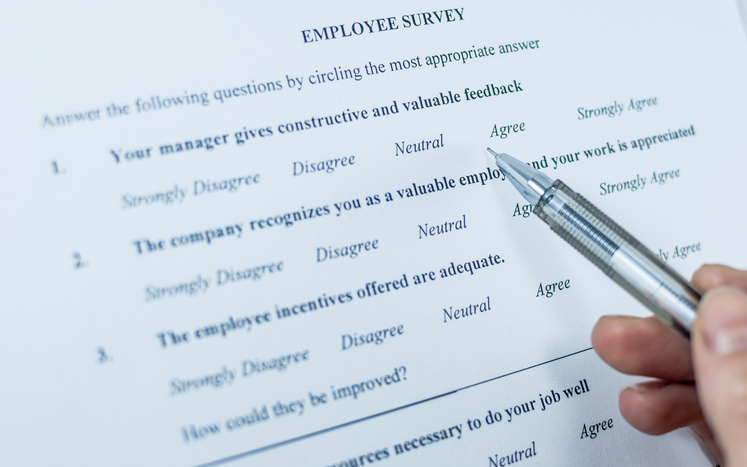Editor’s note: EJ Sieracki is senior director, voice of the employee, at Confirmit, a customer experience and marketing research firm. He is based in Chicago.
 Tempted to dig out last year’s employee engagement survey? Don’t be. It’s been a long time coming, but organizations are finally making moves as they reevaluate employee engagement and prioritizing employee experience. Leaders are realizing that an annual touchpoint just isn’t going to cut it anymore. Just like in any relationship, communication has to happen often – and not just when it suits one party. If you’re overwhelmed just by the idea of constantly listening to employees, capturing insights, improving engagement and driving change throughout the business, it’s OK, you can start small. The key is creating a culture where the voice of the employee (VOE) is valued and used continuously.
Tempted to dig out last year’s employee engagement survey? Don’t be. It’s been a long time coming, but organizations are finally making moves as they reevaluate employee engagement and prioritizing employee experience. Leaders are realizing that an annual touchpoint just isn’t going to cut it anymore. Just like in any relationship, communication has to happen often – and not just when it suits one party. If you’re overwhelmed just by the idea of constantly listening to employees, capturing insights, improving engagement and driving change throughout the business, it’s OK, you can start small. The key is creating a culture where the voice of the employee (VOE) is valued and used continuously.
To be successful, you’ll need to adopt an agile employee experience – an approach built on the proven concept of agile customer experience measurement. Like responsive CX, companies can learn more from and about their employees through continuous conversation instead of hoping one big beast of a survey will give all of the answers. Instead of passively listening, agile employee experience programs are proactive and encourage employees to start conversations. Ready to start mapping out your strategy to listen effectively? Follow these three steps:
1. Create a comprehensive view: When looking to drive engagement, it is critical to develop a responsive, more interactive approach to listening. Just remember: relationships are a two-way street. Successful programs need a combination of both proactive (like ongoing surveys) and reactive (like social media) – making continuous feedback easy and seamless.

This process is critical to developing an understanding of your employees’ impact on a business at every stage. For example, those in front line call center positions have the most knowledge about the customers they speak to daily. They have a clear view on the customer experience, and their understanding of customer pain points is greater than a C-suite executive, for example, who is more removed from direct customer interaction.
Employees might feel like they can make an impact if they were heard, but without a clear opportunity, they will not try to engage or offer feedback. Failing to utilize employees’ knowledge of customer goals, challenges and emotions is not only a huge missed opportunity to benefit the organization, it also brings down overall employee satisfaction and morale. Simply put, it gives the feeling that the company doesn’t value their perspectives, and that never makes for a successful, healthy, long-lasting relationship.
2. Build a feedback culture: Employee engagement strategies like team-centric models provide the structure and framework to capture (and act on) the continually changing dynamics of the business from employees in the trenches and on the front lines. Agile engagement empowers all employees to provide feedback in ways that are meaningful to their department, but within a clear framework to ensure high-quality data and insights for employers. This tactic is ideal for businesses who want to build a culture that thrives on, and drives success from, consistent and collaborative feedback.
However, the success of a program relies on a cultural mind-set as much as it does on the tools and technologies that facilitate this type of continuous listening and analysis. You want every employee to know that giving and acting on feedback is expected. To create an environment where feedback can continuously be accessed to help inform business change, try encouraging proactive participation, creating a safe setting, inspiring innovation and creativity and incentivizing employees to share feedback – not through rewards but by actually acting on their feedback.
 3. Turn knowledge into action: A common gripe from frontline managers is that feedback data is not actionable, outdated or out of their control. Naturally, this can create frustration, causing employees to lose interest, become disengaged or fail to provide useful insights in future. This sounds like a bad break-up might be on the horizon. As we find more ways to collect data, it’s critical to figure out ways to make your incoming data more actionable.
3. Turn knowledge into action: A common gripe from frontline managers is that feedback data is not actionable, outdated or out of their control. Naturally, this can create frustration, causing employees to lose interest, become disengaged or fail to provide useful insights in future. This sounds like a bad break-up might be on the horizon. As we find more ways to collect data, it’s critical to figure out ways to make your incoming data more actionable.
The most effective programs set achievable and culturally aligned goals for feedback follow up, and support those with feedback management platforms and reporting/analytic dashboards to automate the real-time distribution of data. It’s important to remember that feedback programs only deliver value when they deliver change. Evolving as a business through direct feedback allows for immediate and long-term business improvements, but also makes employees more willing to contribute when they see their insights in action.
Agile engagement
Let’s make it a goal to toss out stale employee surveys and implement an agile engagement program to better understand the role your employees play in corporate success. Although the approach takes time, effort and in most cases culture change, organizations will find that actively engaged employees lead to smarter decisions, better business outcomes and long-lasting relationships.
